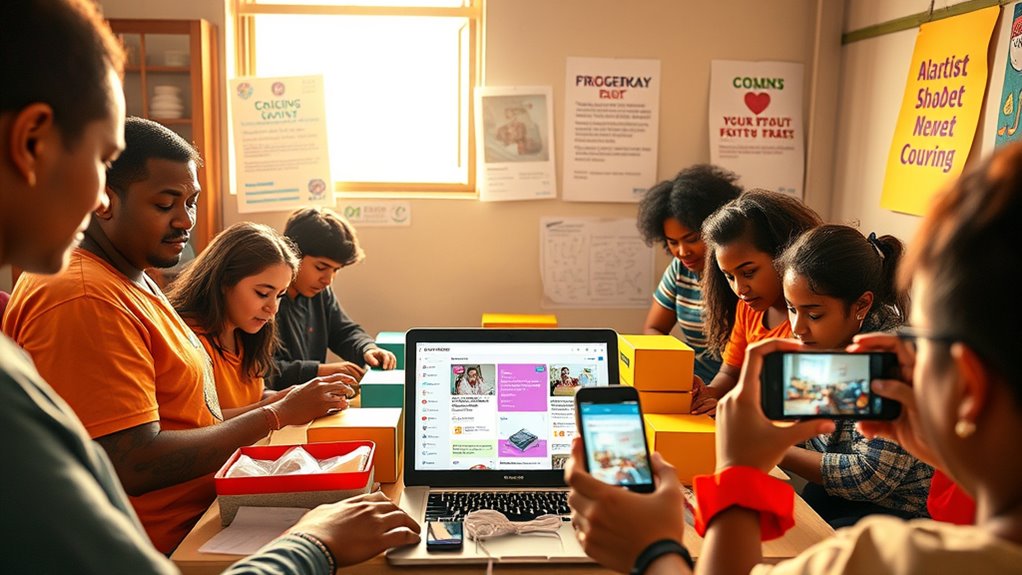You can give back without overspending by getting creative with low-cost fundraising ideas like virtual events, social media campaigns, and peer-to-peer efforts. Partner with local businesses for mutual support, and organize community events using budget-friendly venues and free promotional channels. Recognize supporters with simple rewards and express transparency to build trust and encourage ongoing support. Smaller efforts combined over time can make a big difference—exploring these strategies more will help you maximize impact on any budget.
Key Takeaways
- Host virtual or hybrid events to reduce costs and expand reach, making giving back more affordable.
- Partner with local businesses and community groups for low-cost support and wider visibility.
- Use digital platforms for crowdfunding and peer-to-peer campaigns, maximizing impact with minimal expenses.
- Recognize supporters publicly with creative incentives to foster ongoing engagement without significant spending.
- Leverage free or low-cost promotional channels like social media and community boards to spread your message widely.
Creative Ways to Raise Funds Without Large Investments

With limited resources, nonprofits can still find innovative ways to raise funds effectively. Virtual and hybrid events are excellent options, as they markedly cut overhead costs while expanding your reach. About 44% of organizations now host these events, making participation easier and more flexible for donors. Embedding registration directly on your website streamlines sign-ups, boosting engagement. Hybrid events allow you to reach beyond local communities without hefty expenses, increasing your potential funds. Additionally, peer-to-peer campaigns are highly scalable, recruiting hundreds of new donors with minimal effort. Over 50% of Millennials and Gen Z are willing to fundraise for causes they care about, and these campaigns can generate millions online. Utilizing text messaging appeals and social media amplifies your reach, making grassroots fundraising both affordable and impactful. Nonprofit efficiency ratings show that leveraging these low-cost, high-impact strategies can maximize your organization’s resources while maintaining transparency and accountability. Incorporating cost-effective fundraising methods, like digital campaigns and community partnerships, can further enhance your ability to give back without overspending. Moreover, engaging in traditional craft techniques such as handmade items or creative events can foster community involvement and support, aligning with the spirit of giving back on a budget. Furthermore, understanding the spiritual practices and their impact on well-being can help organizations foster a sense of community and purpose among supporters, strengthening long-term engagement.
Partnering With Local Businesses for Mutual Benefits

Partnering with local businesses offers nonprofits a powerful way to expand their impact while providing tangible benefits to the community. Many companies are increasing their philanthropy, with over 60% boosting giving by more than 15%, and contributing billions annually. Employee engagement is also on the rise, with programs like paid volunteer time and matching gift initiatives, though awareness remains low. Small businesses play a crucial role, donating around 250% more per size than larger firms and supporting local charities, youth groups, and first responders through financial and in-kind contributions. These partnerships help your nonprofit reach new audiences, build trust, and enhance credibility. They also benefit businesses by improving employee satisfaction, attracting talent, and gaining a competitive edge—all while fostering sustainable, long-term community support. Regularly assessing and rotating items to prevent clutter buildup can further enhance the effectiveness of these collaborations and promote a mindful, sustainable approach. Incorporating strategies like community engagement can strengthen these relationships and ensure mutual growth. Building trust through consistent communication and shared goals can deepen these partnerships and lead to more impactful collaborations.
Organizing Community Events on a Budget

Are you looking for ways to host impactful community events without breaking the bank? Start by choosing budget-friendly venues like community centers, parks, schools, or places of worship. Booking early can secure lower rates, and partnering with local government might open grants or subsidies. Recruit volunteers from local schools or civic groups, giving clear roles and recognizing their efforts with certificates or small tokens to keep morale high. Promote your event through free channels like social media, community boards, and local media listings, and partner with neighborhood groups for cross-promotion. Borrow equipment and supplies from community partners, buy in bulk, and repurpose decorations to save costs. Finally, encourage eco-friendly practices like digital tickets and reusable items to reduce waste and expenses. Incorporating data-driven decision making can help you measure success and optimize your efforts for future events to maximize impact and efficiency. Understanding narcissistic manipulation tactics can help organizers identify and mitigate potential conflicts or exploitative behaviors during event planning and execution. Additionally, leveraging sound design techniques can enhance the atmosphere and engagement of your community gatherings. Incorporating somatic awareness practices can also help event organizers stay grounded and responsive during stressful or unpredictable moments.
Leveraging Online Platforms for Cost-Effective Campaigns

Looking for ways to maximize your campaign’s reach without overspending? Online platforms offer powerful tools to do just that. With the average online donation around $52 monthly, focusing on recurring giving can boost your steady income—94% of donors prefer monthly contributions. Digital advertising, like Google Search Ads, delivers a high ROI—about $4.78 for every dollar spent—making it a cost-effective way to attract supporters. Platforms like Fundraise Up and GoFundMe provide AI-driven features, multi-currency support, and easy integration of tax relief options, maximizing donations. Additionally, peer-to-peer and crowdfunding campaigns engage supporters directly, with 34% of donors contributing to these efforts. Using these online tools and strategies helps you reach more people, raise funds efficiently, and build sustainable support—all without breaking the bank. Overall charitable giving increased by 4.1% YoY, which highlights the growing opportunities for online campaigns to tap into increased donor generosity. Emphasizing cost-effective fundraising strategies ensures your campaign remains sustainable and impactful over time. Incorporating privacy considerations by respecting donor data and cookie preferences can also strengthen trust and ongoing support for your cause. Moreover, understanding how home decor elements like wall organization and aesthetic accessories can create inviting spaces can be an inspiring way to connect with supporters and enhance your community engagement efforts.
Incentivizing Support Through Rewards and Recognition

To motivate supporters without breaking the bank, consider creative incentive strategies that resonate personally. Public recognition, like social media shoutouts or certificates, offers powerful, low-cost rewards that encourage ongoing support. Exploring various reward options can help you find meaningful ways to acknowledge contributions and boost engagement effectively. Recognizing efforts not only fosters a positive atmosphere but also increases the likelihood that supporters will remain engaged and committed, as recognition significantly boosts long-term involvement. Incorporating unique dog names into your recognition programs can personalize acknowledgments and deepen supporters’ emotional connection to your cause. Additionally, understanding fundraising laws can ensure that your incentive strategies remain compliant and ethically sound. Being aware of celebrity relationships and their influence can inspire innovative ways to showcase supporter achievements and create buzz around your initiatives.
Creative Incentive Strategies
Creative incentive strategies play an essential role in motivating donors by offering rewards and recognition that go beyond traditional giving. You can provide exclusive experiences like behind-the-scenes tours or VIP event access, creating memorable personal connections. Virtual activities such as cooking or art classes offer community and value without significant costs. Tangible rewards like branded merchandise or chance-based prizes encourage participation, especially when tied to specific goals or time-sensitive challenges. Performance-linked incentives, such as leaderboards or milestone rewards, foster ongoing engagement and friendly competition. Personalized messages and impact updates deepen emotional bonds, making donors feel appreciated and connected. These strategies leverage creativity to incentivize giving while respecting budgets, helping you build a loyal supporter base without overspending. Effective reward and recognition schemes proactively incentivize supporters to move from sign-up to active fundraising, boosting engagement and contributions. Incorporating cost-effective engagement methods can further enhance motivation without straining resources. Additionally, highlighting the tangible benefits of support, such as the direct impact on projects or communities, can motivate continued involvement. Utilizing the power of storytelling can also make the cause more relatable and inspiring for donors.
Public Recognition Benefits
Public recognition serves as a powerful tool to incentivize support by enhancing your social image and prestige. When your name is displayed on a building, printed in newsletters, or acknowledged publicly, it boosts how others see you and your generosity. People tend to give more when their contributions are known, driven by a desire for social approval and respect. Publicly sharing donation amounts can increase giving by appealing to pride or sparing shame. Recognition also helps build a positive social identity tied to philanthropy, encouraging repeated or larger donations. Charities that use public acknowledgment often see higher donation levels and better donor retention. By signaling your support publicly, you become a role model, inspiring others to give and creating a culture of generosity. Research shows that public recognition primarily enhances social status, not necessarily influencing others’ donations.
Reward Variety Options
Offering a variety of rewards can substantially boost support for your charity by motivating donors and volunteers through both tangible and intangible incentives. Financial matching programs are especially effective; 65% of large companies and 28% of smaller ones offer these, encouraging larger donations. Donors are 84% more likely to give when matching is available, with many leaving billions in unclaimed funds. Non-monetary rewards like badges, certificates, or exclusive event access also increase participation and satisfaction. Customized rewards that reflect donor preferences foster loyalty and ongoing support. Tiered systems motivate incremental giving, while digital platforms make reward distribution scalable and cost-effective. Using data analytics helps identify the most impactful rewards, allowing you to refine your approach and maximize engagement without stretching your budget. Workplace giving raises approximately $5 billion annually, providing a significant resource for charitable initiatives.
Recycling and Reuse Initiatives for Environmental and Financial Gains

Recycling and reuse initiatives play a crucial role in achieving both environmental and financial benefits. Globally, countries like Slovenia lead with a 72% municipal recycling rate, reducing landfill use and greenhouse gases. Germany and South Korea follow closely, showcasing effective waste management. In the U.S., about 59% of households have curbside recycling access, but only 59% participate, leading to nearly 79% of recyclables ending up in trash. Recycling rates vary widely by state, with some losing over a million tons of recyclables annually. Improving these programs through public education, streamlined collection, and policies like Extended Producer Responsibility can boost rates. Recycling programs are also impacted by consumer awareness and behavioral habits, which can be improved through targeted outreach. Recycling not only conserves resources but also cuts waste disposal costs, supports sustainability, and lowers environmental impact—making it a wise choice for both individuals and communities.
Engaging Volunteers to Maximize Impact and Minimize Expenses

You can maximize your charity’s impact by recruiting volunteers through social media, word-of-mouth, and community events, all while keeping costs low. Empowering local community leaders to champion your cause expands your reach and builds trust without extra expenses. By strategically involving volunteers and community advocates, you’ll strengthen your organization’s reach and efficiency on a budget.
Volunteer Recruitment Strategies
Effective volunteer recruitment is essential for maximizing your charity’s impact without stretching limited resources. Leveraging digital platforms like Facebook, Instagram, and Twitter helps showcase volunteer stories, behind-the-scenes content, and testimonials that inspire others. You can even let volunteers take over social media temporarily to share authentic experiences. Targeted paid ads based on location and interests attract suitable volunteers, while including direct application links simplifies sign-ups. Develop formal recruitment plans focusing on specific skillsets aligned with your goals. Mix broad appeals with targeted outreach through community events, professional networks, and print materials. Use the table below to visualize your strategies:
| Channel | Method | Focus |
|---|---|---|
| Digital Media | Social media campaigns, ads | Engagement and sign-ups |
| Formal Plans | Documented recruitment strategies | Skill matching |
| Community Outreach | Events, flyers, word-of-mouth | Local visibility |
| Network Referrals | Encourage volunteer recommendations | Trust and quality |
| Engagement | Clear roles, recognition, ongoing support | Volunteer retention |
Empowering Community Leaders
Have you considered how empowering community leaders can substantially boost your charity’s impact while keeping costs low? When leaders are trained in volunteer management, they can recruit, motivate, and organize volunteers locally, reducing administrative costs. Empowered leaders can resolve conflicts, communicate effectively, and adapt to community needs, improving program delivery. Giving leaders tools for decision-making and autonomy encourages ownership, leading to higher engagement and sustainability. Effective volunteer management reduces volunteer turnover and enhances program consistency. Build local capacity through targeted training for leaders. Enable leaders to recruit volunteers from their communities. Equip leaders with conflict resolution and communication skills. Foster independence to adapt programs swiftly. Cultivate a sense of ownership, boosting long-term volunteer commitment.
Combining Small Fundraisers for Sustained Support

Why is combining small fundraisers an essential strategy for nonprofits aiming for sustained support? It helps you engage donors consistently, reducing dependence on seasonal spikes. Regular events keep your organization top of mind and build loyalty, especially as donor retention declines by 4.6%. Plus, small-scale fundraisers let you test new strategies with less risk before expanding. Combining these efforts diversifies income streams, decreasing reliance on large, infrequent gifts.
| Benefit | Strategy |
|---|---|
| Engagement | Host multiple small events |
| Accessibility | Use in-person and virtual options |
| Testing | Try new approaches risk-free |
| Income Diversification | Spread donations year-round |
| Donor Loyalty | Maintain continuous contact |
Transparent Communication to Foster Trust and Long-Term Giving

Sharing impact stories and clearly showing how funds are used helps build trust and keeps donors engaged. Maintaining open dialogue across multiple channels shows you’re approachable and committed to transparency. When you communicate honestly and consistently, donors feel confident in their support and are more likely to give long-term. Implementing detailed financial reports and visual aids further demonstrates accountability and reassures donors of your organization’s integrity.
Share Impact Stories
Transparent communication through impact stories is essential for building trust with donors and encouraging long-term support. When you share stories that highlight real beneficiaries and tangible outcomes, you humanize your data and create emotional connections. Donors want to see the results of their contributions, so combining numbers with heartfelt narratives makes your impact more compelling. Be open about both successes and setbacks; this transparency demonstrates credibility and accountability. Use digital tools like photos, GPS coordinates, and updates to verify progress and foster trust. Additionally, openly acknowledging areas for improvement shows your commitment to growth. Impact reports are proven to increase donor retention and engagement, which further emphasizes the importance of ongoing transparent storytelling. – Share stories that connect emotionally and provide context. – Balance positive outcomes with honest challenges. – Use visual evidence for authenticity. – Regularly update donors across channels. – Highlight long-term, sustained benefits.
Highlight Use of Funds
Clear communication about how funds are used builds trust and encourages ongoing support. When you openly share details about donation allocation—such as programs, administration, and fundraising—you demonstrate fiscal responsibility. It’s crucial to disclose key financial metrics, like liabilities versus assets, to show stability and sustainability. Regularly publishing audited financial reports online reassures donors that funds are managed properly. Using simple summaries or infographics helps make complex financial data accessible, increasing transparency and engagement. When donors see how their contributions directly support the organization’s mission, they’re more likely to give again. Honest reporting of non-cash contributions and progress toward goals further enhances credibility. Research shows that nonprofits that share information proactively experience a 53% increase in donations the following year. Overall, transparent communication about funds fosters long-term relationships, deepens trust, and encourages donors to stay committed to your cause.
Maintain Open Dialogue
Maintaining open dialogue is essential for building lasting trust with your supporters, and doing so requires proactive, honest communication across multiple channels. By staying accessible through social media, email, calls, and private messages, you show you’re committed to transparency. Assign dedicated team members to monitor each platform, ensuring no message goes unanswered. Respond promptly, sincerely, and respectfully to all inquiries, reinforcing trust. Keep supporters informed with regular updates like newsletters that highlight achievements and upcoming plans. Balance communication frequency to avoid overwhelming your audience. Public disclosure of financial documents is a key aspect of transparency that reassures supporters about your organization’s accountability. Use diverse channels to reach different demographics. Assign staff to ensure timely responses. Share updates consistently to foster engagement. Maintain transparency with financial and organizational info. Respectfully address questions, even when challenging.
Tracking Outcomes to Optimize Fundraising Strategies

Tracking outcomes is essential for refining your fundraising strategies and ensuring your efforts have lasting impact. By monitoring key metrics like donor acquisition rate, retention rate, and donation growth, you gain insights into campaign effectiveness and supporter engagement. Using tools like CRM systems (Salesforce, DonorPerfect) and analytics platforms (Google Analytics, Mailchimp), you can gather real-time data to make agile adjustments. Integrating these systems guarantees thorough, accurate insights, helping you identify which activities produce tangible results versus simple outputs. Differentiating outputs from outcomes allows you to demonstrate actual impact, strengthening your case to donors. Regular analysis of data on donor behavior, cost efficiency, and campaign performance guides strategic decisions, maximizes your budget, and builds trust with supporters committed to your mission.
Frequently Asked Questions
How Can I Ensure Legal Compliance When Hosting Online Raffles?
When hosting online raffles, you need to follow your state’s laws carefully. Check if online raffles are permitted for nonprofits and obtain any required permits or licenses. Make certain there’s a no-purchase entry option, keep detailed records, and clearly disclose rules and deadlines. Avoid selling tickets to minors and maintain transparency about how funds are used. Consulting legal advice can help you stay compliant and avoid legal issues.
What Are the Best Ways to Motivate Volunteers Without Monetary Incentives?
You want to motivate volunteers without monetary incentives? Focus on recognizing their efforts, celebrating achievements, and sharing success stories. Offer opportunities for personal growth, like training and skill development, to boost their confidence. Create a welcoming environment that fosters belonging, encourages participation, and values their input. By aligning tasks with their passions, providing meaningful recognition, and supporting their development, you inspire sustained commitment and heartfelt engagement.
How Do I Choose the Right Local Businesses for Partnerships?
When choosing local businesses for partnerships, you focus on their reputation, values, and relevance to your mission. Look for companies with a strong community presence, shared CSR goals, and compatible cultures. Use your network to identify potential matches, then do your due diligence to guarantee alignment. Prioritize those willing to grow with you, offering mutual benefits like brand visibility and resource support, creating a genuine, long-term collaboration.
What Platforms Are Most Effective for Low-Cost Digital Fundraising Campaigns?
When choosing platforms for low-cost digital fundraising, focus on those that maximize your reach and engagement affordably. Meta offers cost-effective advertising with high ROI, while TikTok’s large, young audience can boost awareness despite higher costs per donation. Peer-to-peer platforms like 99Pledges and GoFundMe are user-friendly, cost-efficient, and great for social sharing. Prioritize platforms with mobile-friendly features, transparent fees, and multi-language options to expand your donor base effectively.
How Can I Measure the Success of Small, Community-Based Events?
Measuring small event success is like tracking a garden’s growth—small steps matter. You should monitor attendance, engagement levels, and participant feedback to see how well you’re reaching your goals. Keep an eye on funds raised and sponsor support to gauge financial success. Use post-event surveys to gather insights and analyze conversion rates. These metrics help you understand impact and plan improvements for future community events.
Conclusion
You can make a big impact without breaking the bank by combining creative fundraising ideas, leveraging local partnerships, and engaging your community. Think of it like planting a garden—small seeds like online campaigns and volunteer efforts can grow into a thriving support system. With transparent communication and tracking, you’ll see your efforts flourish over time. So, don’t worry about big budgets—your heartfelt actions and smart strategies can truly make a difference.









